We Are Here to Help!
What to Expect from Us:
No Pressure, Just Service!
Get no obligation pricing details and strategies that will work for your business.
Maintenance schedules lie at the heart of HVAC (Heating, Ventilation, and Air Conditioning) operations, ensuring that residential and commercial systems run optimally, efficiently, and reliably. Encapsulate a detailed yet customer-friendly presentation of your maintenance schedule in your marketing efforts to make your HVAC business soars. Here are some strategic insights to enhance your HVAC direct mail marketing approach and improve your overall HVAC marketing strategy.
Elements of Direct Mail for HVAC Marketing
Let your mailers stand out by incorporating these elements in your HVAC direct mail marketing strategy. Being intentional with your HVAC advertising can enhance your engagement with potential customers and boost your business success.
According to the United States Postal Service, direct mail significantly influences consumer behavior, with 50% of people trying a new product, service, or establishment within the past six months after receiving an advertisement in the mail. The influence of direct mail is higher than any digital marketing, email marketing, or Google ads statistic. It highlights the effectiveness and impact of direct mail marketing in capturing attention and generating interest among potential customers.
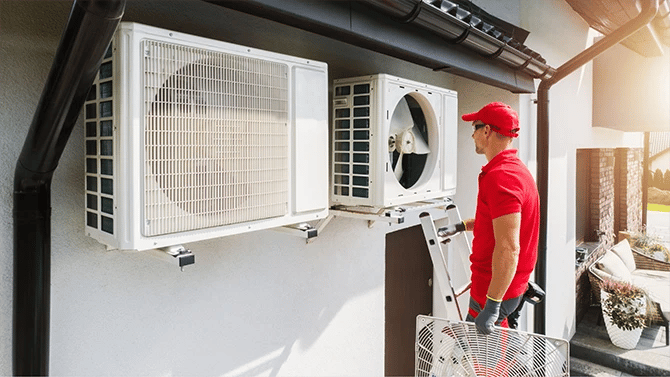
Whether you employ a marketing agency to plan your direct mail campaign or skip marketing services and decide to do it yourself, here are the crucial elements that you should include in your direct mail postcards:
Captivating Design
Your direct mail piece should be engaging and visually appealing. Use colors and fonts that promote brand awareness and reflect the professionalism and reliability of your HVAC services. Include images that resonate with comfort and quality, ensuring potential customers feel a sense of trust and assurance.
User-Friendly Language
Make your message clear and compelling by using simple and engaging language. Highlight the HVAC services you offer, like installation, maintenance, and repair, making it easy for new customers to understand your value.

Compelling Call to Action (CTA)
Each postcard must have a strong call to action. Invite customers to schedule a service or contact you for more information. You can even introduce your HVAC digital marketing through traditional advertising. Provide a QR code for them to visit your website, follow you on social media, or sign up for email marketing. Remember to make it easy for a potential customer to take the next step in engaging with your services by including all important contact details.
Accurate Mailing List
Take note of your service area and build and maintain a targeted mailing list. Regularly update the list of mail recipients to keep the information accurate and relevant, ensuring your mail reaches the right audience. Expand your list by adding potential customers who might benefit from your HVAC services, using opportunities such as community events or partnerships.
Personal Connection
Consider adding online reviews, testimonials, or success stories of existing customers to build credibility. Sharing positive experiences from satisfied customers can help create a stronger connection and trust with potential clients.
Maintenance Insights: Tailoring HVAC Messaging
Tailoring your direct marketing messaging to your target audience is crucial for the success of your marketing strategies. Whether you're targeting homeowners or businesses, here are some recommendations on how to make your messages more relevant to a potential customer.
Check out our targeted mailing list with options such as consumer, business, and even new movers.
Residential Customers: Seasonal Focus on Messaging
Your HVAC customer's systems may require different care every season. Your direct mail campaign can promote essential services that guarantee a home's warmth in winter and coolness in summer, ensuring that homeowners feel confident and cared for.
- Spring: Emphasize services such as air filter changes, thermostat setting adjustments, and outdoor unit inspections.
- Summer: Highlight the importance of cleaning condenser coils and checking refrigerant levels.
- Fall: Showcase your expertise in inspecting and cleaning the blower assembly.
- Winter: Convey the significance of checking gas or oil connections and inspecting the heat exchanger.

Commercial Customers: HVAC Maintenance Communication
Your communication is important in showcasing excellence to other local businesses. Emphasize how you diligently execute regular and rigorous checks that cover every vital aspect with meticulous care and specialized expertise. An effective direct mail campaign will communicate how your service commitment is about maintenance and ensuring absolute comfort to the end-users.
Professional Assurance
Guarantee your clients a business environment that consistently offers comfort while adhering to all regulatory standards.
- Indicate the need for regular and rigorous checks, such as calibrating thermostats and controls and inspecting ductwork across all seasons.
- Underline the significance of specialized care, like cleaning burners and inspecting heat exchangers in colder months.
Emphasizing Safety
Safety is a prime concern for commercial entities, and underscoring this aspect will enhance their trust in your services. Highlight your commitment to safety by focusing on checks like verifying smoke detectors, carbon monoxide detectors, and emergency shut-offs.
In-depth Professional Inspection Promotion
To reinforce your HVAC service's credibility and expertise, promote the concept of professional, in-depth annual inspections. This meticulous service is designed to prolong the longevity of the HVAC system and maintain energy efficiency. It is tailored according to the manufacturer's recommendations and local regulations.
Building a Record of Reliability
A meticulous record-keeping process is fundamental to an HVAC company's commitment to transparency, efficiency, and top-tier service quality. Maintaining records will enable you to optimize your service, enhance customer satisfaction, and ensure that each HVAC system you manage operates at peak efficiency and reliability.
Here are examples of the detailed records you can maintain and promote in your HVAC advertising:
- Customer Communications
- Maintenance Schedules
- Service Histories
- Inspection Reports
- Parts and Inventory
- Technician Notes
- Warranty Information
- System Specifications and Manuals
- Regulatory Compliance Records
- Energy Efficiency Data
- Invoicing and Billing
- Emergency Response Logs
- Training and Certification Records
- Supplier and Vendor Information
- Customer Satisfaction Surveys
Suggest An HVAC Maintenance Schedule
Maintenance schedules for HVAC (Heating, Ventilation, and Air Conditioning) systems in residential and commercial properties are essential to ensure efficient and reliable operation. While the specific schedule may vary based on the type of HVAC system and local climate conditions, you can use these as a general guide for your HVAC postcard marketing efforts.
Residential HVAC Maintenance Schedule
A typical residential maintenance schedule for each season:
Spring
- Change or clean air filters: This should be done every 1-3 months, depending on the type of filter and the system's usage.
- Check the thermostat settings: Ensure the settings are appropriate for the season.
- Inspect outdoor unit: Remove debris and trim vegetation around the outdoor condenser unit.
- Test the system: Briefly turn on both heating and cooling modes to ensure they work correctly.
Summer
- Clean the condenser coils: Remove dirt and debris from the outdoor unit's coils.
- Check refrigerant levels: Ensure proper refrigerant levels for efficient cooling.
- Clean evaporator coils: Remove dust and dirt from the indoor evaporator coils.
Fall
- Inspect the blower assembly: Clean the blower wheel and housing.
- Lubricate moving parts: If necessary, lubricate bearings, motors, and other moving parts.
Winter
- Check gas or oil connections: Ensure no leaks if you have a furnace.
- Inspect heat exchanger: Look for cracks or damage in the heat exchanger.
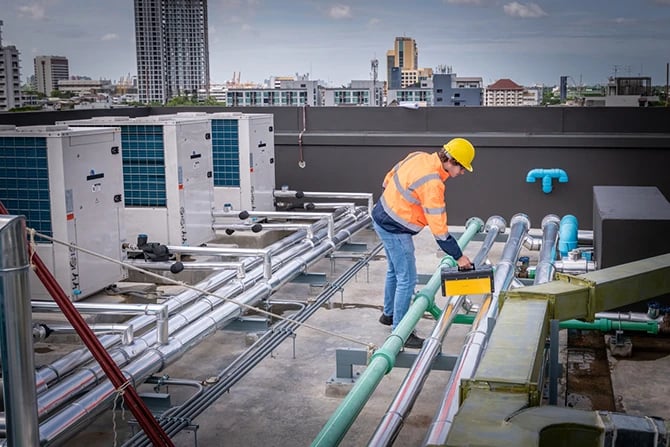
Commercial HVAC Maintenance Schedule
A typical commercial maintenance schedule for each season:
Spring
- Change or clean air filters: Follow a strict schedule every 1-3 months.
- Calibrate thermostats and controls: Ensure precise temperature and humidity control.
- Inspect ductwork: Check for leaks or damage in the ducts.
- Test safety systems: Verify that smoke detectors, carbon monoxide detectors, and emergency shut-offs are functioning properly.
Summer
- Clean condenser and evaporator coils: Remove dirt and debris to maintain efficiency.
- Check and adjust refrigerant levels: Ensure optimal cooling performance.
- Inspect and clean drain pans and lines: Prevent clogs and leaks.
Fall
- Inspect and clean burners: Ensure clean and efficient combustion for heating systems.
- Test pilot lights and ignition systems: Verify proper ignition.
- Lubricate moving parts: Keep motors, fans, and other components well-lubricated.
Winter
- Inspect heat exchangers: Look for cracks or damage, especially in gas-fired furnaces.
- Check safety controls: Verify that all safety systems are operational.
- Test emergency systems: Ensure backup heating or cooling systems are functional.
HVAC Business Direct Mail Calendar: Quarterly Recommendations
Your HVAC business can provide valuable, timely advice to customers, encouraging them to maintain their systems regularly while positioning your services as essential to their comfort and safety throughout the year by focusing on these quarterly themes.
Q1: Winter Preparation or Spring Readiness
Communications should emphasize preventive maintenance to avoid emergency repairs during seasonal transitions.
- January to March: Kick off the year by focusing on winter maintenance tips, stressing the importance of inspections for residential and commercial HVAC systems to ensure preparation for the cold. Alternatively, as spring approaches, shift the narrative towards preparing systems for warmer weather, including managing air filters and thermostats.
Q2: Summer Preparation and System Health
Emphasize the importance of staying consistent with maintenance schedules for optimal performance.
- April to June: This quarter is about preparing for summer heat and maintaining system health. Begin with advice on keeping detailed records of HVAC maintenance, then move towards getting systems ready for the summer. Highlight the necessity of cleaning and checking all parts of HVAC systems to ensure they function efficiently.
Q3: Embracing the Heat and Preparing for Fall
This period is critical for ensuring systems are not overburdened by the summer heat and are ready for the temperature drop.
- July to September: As the peak of summer arrives, focus on keeping commercial HVAC systems running smoothly during high temperatures. Transition into fall preparation by the end of the quarter, advise clients to check and prepare essential parts of the HVAC system for the cooler months ahead.
Q4: Transitioning to Winter and Annual Review
Conclude the year by encouraging a comprehensive review of the past year's maintenance activities, highlighting the importance of tailored maintenance schedules based on local weather patterns and manufacturer recommendations to optimize performance and longevity.
- October to December: Dedicate this quarter to preparing HVAC systems for winter and conducting a year-end review of the system's maintenance history. Begin with tips on transitioning into the colder weather, ensuring both residential and commercial systems are ready for the drop in temperature.
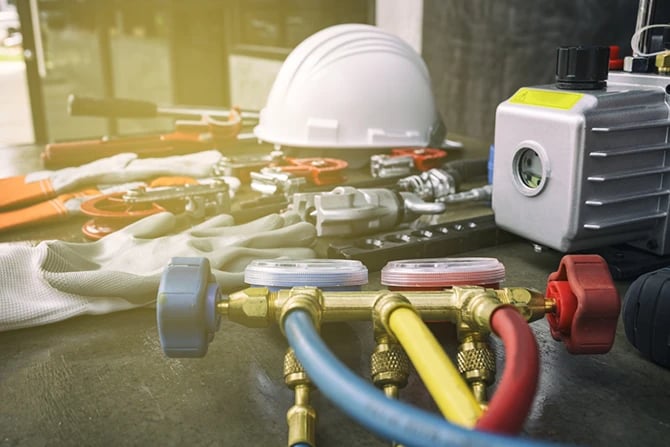
Conclusion
As a professional HVAC technician or contractor, emphasize that you keep records of all inspections, repairs, and servicing. Highlight in your HVAC direct mail marketing that by performing more in-depth annual inspections and maintenance, you help your clients prolong the life of their HVAC system and maintain energy efficiency.
Effectively communicating detailed maintenance recommendations to your mail recipients in a customer-centric manner will significantly enhance your HVAC marketing strategy. Direct marketing through postcards can build strong connections with residential and commercial clients and ensure your HVAC business's flourishing success.🌬🔧
Our postcards have helped various businesses get leads, boost awareness, and grow revenue. Let us help you create a postcard design to achieve your marketing goals.

 Jill Brown: Apr 01, 2024
Jill Brown: Apr 01, 2024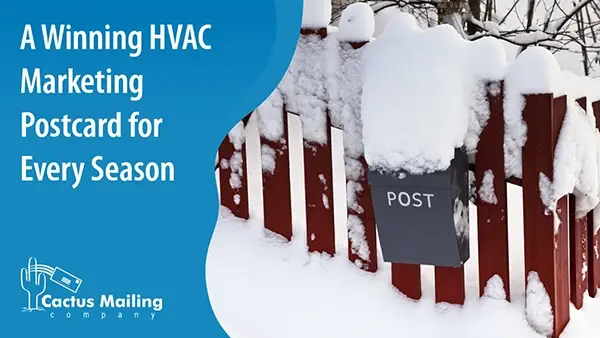


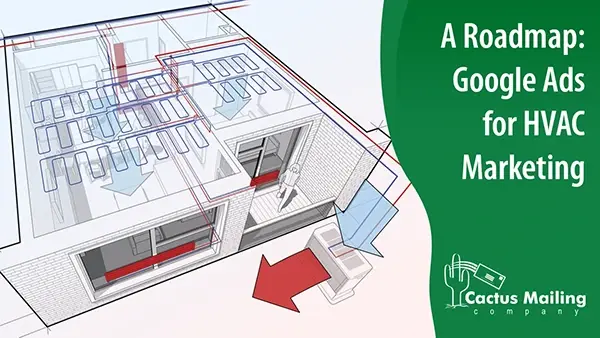
 Cactus Mail Team
Cactus Mail Team
